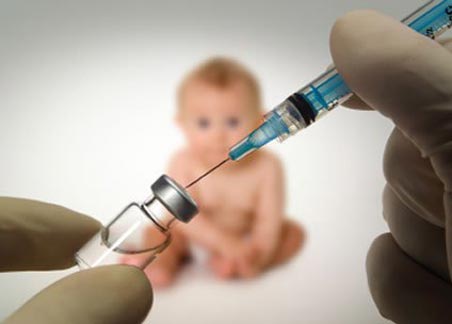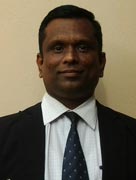Another shot against polio
Injectable IPV introduced as a means to ensure
poliomyelitis stays away from Sri Lanka:
by Carol Aloysius
Last week the Epidemiology Unit introduced the new injectable
Inactivated Polio Vaccine (IPV) for 4-month-old infants, as part of its
national Expanded Immunization Programme (EPI) to completely eradicate
poliomyelitis (polio) from Sri Lanka. Sri Lanka had been free of polio
since 1993 and the South East Asian region since March last year.
However, given the contagious nature of the polio virus, which invades
the nervous system through the mouth, often with food or drinking water
and causes paralysis and even death, the injectable IPV is being
introduced as a part of the global effort to completely wipe out
poliomyelitis by 2018. Here, Chief Medical Officer, Mt Lavinia, Dehiwala
and Ratmalana Municipal areas, Dr Indika Ellawala, discusses the virus
and the vaccine
Excerpts...
 Q:
Polio is a disease we rarely hear of today. So many are unaware as to
how it is caused or spread. Just how infectious is it? Q:
Polio is a disease we rarely hear of today. So many are unaware as to
how it is caused or spread. Just how infectious is it?
A: It is a highly infectious neurological disease manifesting
with acute flaccid paralysis by the polio virus.
Q: Are there sub-types? If so for how long do they survive?
A: The Polio virus has 3 sub types P1 P2 and P3. It does not
survive long in the environment outside the human body and is rapidly
inactivated by heat, formaldehyde, chlorine and ultra violet light.
Q: So how is it transmitted?
A: Through the faeco-oral route. It enters the blood stream
from the GI tract and attacks the motor neurons causing paralysis. The
virus is shed in the faeces. In poor sanitary conditions with poor
hygiene environments, it can infect other persons if transmitted by
dirty hands or contaminated food and water.
Q: Are all those living in such environments at risk?
A: Those with strong intestinal immunity and nutritious diets
can resist transmission.
Q: Who are those most at risk?
A: People of all ages, but mostly it targets those under five
years.
Q: Sri Lanka has achieved zero level eradication of Polio,
even ahead of the Global Programme. What were the main strategies used
to this end in the recent past?
|
Benefits
of IPV
*IPV has been used in over 60 countries
worldwide, over decades
*IPV is a very safe vaccine, whether used alone or in
combination vaccines
*No serious side effects have been reported, only minor side
effects
*Minor local reactions may occur following IPV, as can
sometimes happen with other vaccines. But a child will
recover
*IPV is a very safe vaccine. |
A: The main strategies of Polio Eradication include: strong
routine immunisation programme, high uniform coverage with OPV,
supplementary immunization activities such as immunizing children below
15 years of age among returnees from South India, and mop up campaigns
i.e. intensive immunization campaigns in the last remaining foci of
transmission. We also conduct surveillance to detect possible new cases
of polio.
Q: Tell us more about the vaccines uses and their benefits.
A: At present we use two vaccines, OPV (Oral Polio Vaccine)
and IPV. OPV is the preferred vaccine used in the Polio Eradication
Initiative.
Q: Why?
A: Because OPV offers effective protection against polio. It
is administered by drops and has been found highly successful in
reducing transmission in developing countries. It is also inexpensive,
easy to administer, provides humoral and mucosal /gut immunity and
protects close contacts who are unvaccinated.
Q: It has been reported under the Global Polio Eradication
Plan to have a polio-free world, told that the World Health Organisation
had recommended the use of OPV should be eventually stopped worldwide.
Your comments.
A: OPV will be withdrawn in two phases beginning with type 2
OPV. WHO’s Strategic Advisory Group of Experts recommended that all
countries introduce at least one dose of IPV into their routine
immunization schedule by the end of this year (2015), before type 2 OPV
is withdrawn, to reduce risks of an outbreak after its withdrawal, to
help stop outbreaks quickly and to boost immunity against polio types 1
and 3 to protect the people against it and hasten eradication.
|

Dr Indika Ellawala |
Q: In other words, the introduction of IPV sets the stage for
withdrawing the OPV entirely?
A: When use of OPV is eventually stopped, IPV will continue to
provide full protection. IPV administered after a few doses of OPV not
only enhances protection against the paralytic disease, but also boosts
intestinal immunity, even more than an additional dose of OPV would
provide. In short, combining the two will offer advantages of both
vaccines, namely, strong intestinal immunity, anti body protection
against the two serotypes in OPV, types 1and 3.
This combination gives both the child and the community the best
protection.
Q: What about Inactivated Polio Vaccine (IPV) which is used in
most developed countries?
A: This vaccine is administered by injection and is also
highly effective though more expensive than OPV, and requires trained
health workers. Like OPV it provides good humoral immunity.
It is also one of the safest vaccines, whether used alone or in
combination with other vaccines, with minimum side effects. It has been
in over 60 countries worldwide over decades.
However IPV has high heat sensitivity. Hence it has greater
susceptibility to heat than many existing heat sensitive vaccines.
Proper temperature monitoring and stock management is required to avoid
wasting IPV vials with VVM reaching the discard point
Q: At what age should IPV be administered?
A: You can give IPV at or after age 14 weeks, usually with
OPV2 and Penta 2 when the child is 4 months of age.
• Give one dose of IPV, together with OPV
• Both vaccines together provide the strongest polio immunity
• IPV may be given with other injectable vaccines
• IPV should be given at 14 weeks or at the first contact after 14 weeks
Q: On which part of the infant’s body will the injection be
administered?
A: On the thighs.
Q: Are the health staff at most hospitals trained for this?
A: All government hospitals were sent circulars giving details
on how they should give the injections and the hygienic practices to be
followed including proper waste disposal, by the Director General Health
Services, ahead of the programme. So everyone is trained for this task.
Most leading hospitals have also been given ice line refrigerators,
especially designed to store the vaccines.
Q: Has the Health Ministry made the public aware about IPV and
its benefits?
A: All hospitals were sent illustrated leaflets giving details
of the new vaccine and its benefits and assuring parents it is very safe
with no side effects. These leaflets have been distributed free to all
mothers attending ante natal and Maternal and Child Health clinics as
well as Well Mother clinics island-wide.
Health workers play important roles in parent and caregiver accepting
vaccinations for their children.
Q: How?
A: Some parents and caregivers may not understand why their
child needs an additional vaccine for polio. Hence they may be concerned
about receiving multiple injections on the same visit.
By listening patiently, understanding, encouraging and communicating
effectively with caregivers, health workers can ensure that children
receive vaccines and return for future vaccinations. The Health Ministry
has given them careful instructions on how they should do this.
Q: Are these sessions interactive. Do they give caregivers and
parent a chance to express their fears and concerns?
A: Yes, All these programmes which communicate the message to
the public allow the caregivers to talk encourage them to ask questions.
Give them full attention. Listen to their concerns and respond to them
politely. Correct any misconceptions they may have. And to keep your
body language positive.
In addition they have been told that if they did not know the answers
to certain questions, they should not dismiss the question, but promise
to give the correct information at a future date.
Q: Your message to parents?
A: Combining IPV and OPV provides stronger protection against
polio.
The dose of IPV will help protect your children against polio disease
even more – and will give your child the benefits of both vaccines. IPV
strengthens immunity in the blood, while OPV strengthens immunity in the
gut.
Using both vaccines together provides the best form of protection
from polio – it protects your child and helps protect our community.
Parents should know that giving a child several vaccinations during the
same visit allows your child to be immunized as soon as possible.
They are protected against multiple diseases during the most
vulnerable early months of life. In addition, giving multiple
vaccinations at one time means fewer vaccination visits for parents and
caregivers. .
In many countries, children receive more than one vaccine injection
in one visit. Early vaccinations mean early protection for the child.
Q: What about their concerns about any pain caused to the
child with an injection vaccine?
A: Our answer is, “It is better for the child to experience
one, brief moment of discomfort than pain on two separate days.” |

